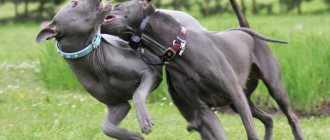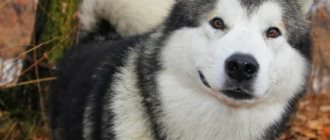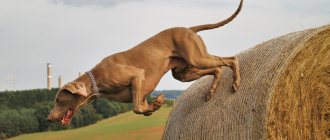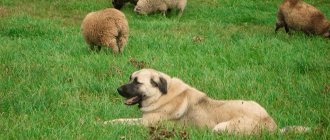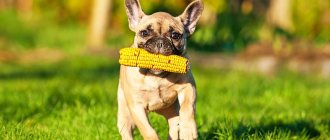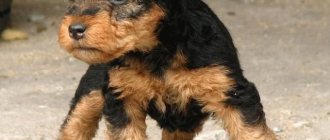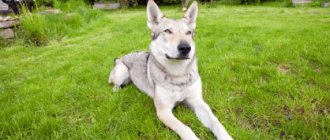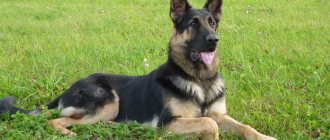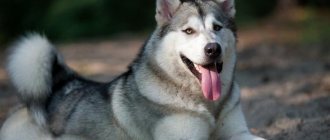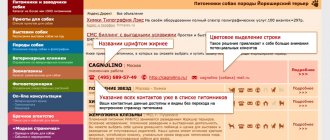Description of the Irish Setter breed
Popularity 213 place among 263 dog breeds
Lifespan:
13-15 years old
Breed group:
Cops
Height:
males: 58-67 cm, females: 55-62 cm
Country of origin:
Ireland
Average price:
20-30 thousand rubles
Weight:
27-32 kg
Latest articles Cat health
Rabies vaccination for cats: choice of vaccine, necessity, schedule 01/22/2022 15 0 0
Selection and adaptation
TOP 20 best cat breeds for families with children 01/22/2022 27 0 0
Kinds
The breed group includes four breeds. They are all genetically close relatives. English Setters are mostly two-colored. The background color of the coat is white. There are small spots scattered across it. Their color can vary from black to lemon.
Sometimes there are tricolor dogs. With a white background and spots of two colors. Setters from Britain have a unique stance. When they spot game, they lie down. Setters bred in Ireland have two breed lines corresponding to two colors:
- red and white - spotted or piebald;
- red - monochromatic.
The piebald setter began to be cultivated earlier. From it came a variety with ruby-colored wool. The shimmering color has captivated all lovers and breeders. These cops have become an independent breed. And for some time they forgot about the spotted version; the name Irish Setter was assigned to a red dog.
Another variety is the setter, obtained by Scottish breeders. The dogs have black and tan fur. It stands out among other setters in terms of power and the worst speed qualities. They are sometimes called Gordon setters or simply Gordons.
Key facts
The characteristics of the Irish Setter breed say that these dogs are very active, affectionate animals that need constant communication with humans and their attention. They are true lovers of games, running, and carry out various tasks with joy and sparkles in their eyes. The breed is not suitable for those who are often away from home.
Wool is the calling card of setters. They shed little, but to maintain their excellent appearance, quality and beauty, the fur must be properly cared for. The description of the Irish Setter breed emphasizes this need as a matter of course.
Having the makings of professional hunters, they find game at the right moment. At the same time, they are completely incapable of being strict guards or defenders, much less showing anger and aggression. The Irish often play the role of faithful home companions, they know how to calm people down and help relieve emotional tension or stress.
Despite their peaceful nature, as adults it is difficult to force setters to do anything unusual. Therefore, it is better not to delay education and training. These pets are truly loyal friends who also perfectly perform the role of “nannies” - they love to tinker and have fun with the kids.
Irish Setters are quite athletic, so they need regular training, constant movement, and do not like to sit idle for a long time. These four-legged beauties require constant physical activity in the form of various running and strength training, active developmental and educational games. Reservoirs, lakes, even simple puddles are their great love.
The health of setters is not bad, and with proper care the dog feels absolutely great. The life expectancy of the Irish Setter is 13-15 years, and occasionally long-livers are found among them.
Professional puppies are more expensive
A puppy from a professional breeder will undoubtedly cost more than puppies from many other advertisements. Because this is work that takes a lot of time, effort and requires considerable financial investments. Do you want to buy a healthy, properly raised puppy from purebred, titled parents? Now let's think about what's behind this:
- regular veterinary supervision:
- Costs for proper dog nutrition:
- participation in exhibitions, which requires a significant investment of money (which you will also need to be prepared for if you are going to actively train your dog):
- payment for mating with a stud dog (sometimes monetary, and sometimes the owner of the dog takes one puppy from the litter).
These are expenses that the breeder incurs even before the puppies are born.
Puppies need to start feeding from 3 weeks or earlier, depending on the size of the dog and the number of puppies in the litter, undergo the necessary cosmetic surgeries (ears and tails are trimmed), and vaccinated.
The amount we pay for a puppy does not even always cover the costs incurred by the breeder. Therefore, is it worth choosing based on the cheap price?
Look for your puppy from professional amateurs, but do not forget that there are exceptions to everything: you can meet a professional who has been involved in the breed for many years, who later will not even remember you or the puppy you bought from him, or you can find one like this a breeder who has not been in the breed for long, but has proven himself to be a responsible person (and there are plenty of them) - you can safely choose a puppy from him! I wish you success!
History of the origin of the Irish Setter
The breed of hunting Irish red setters is considered “secret”. It was first mentioned in records created in the 15th century. “Setters” were not the name given to the dogs themselves, but to any animals intended for hunting game birds. Having an unusually keen sense of smell, the shaggy hunters without hesitation determined where the bird was, accurately and quickly guiding the person straight to it.
There is no exact information about the origin of the dogs and their family ties. But there are suggestions that their relatives are spaniels, pointers, bloodhounds, even wolfhounds. But there is no clear official confirmation of this.
Targeted breeding began in the 80s of the 18th century in Ireland. It was then that the first stud books were created. But until the 50s of the 19th century, the breed was not fully recognized. For this reason, at various exhibitions or festivals the animals were presented together with other types of setters. But about 10 years later, in the 90s, Irish Reds were officially declared a separate breed. Around the same time, the first Irish Dog Lovers Club opened in Dublin, and in 1885 the basics of exterior training were released.
At the end of the 19th and beginning of the 20th centuries, European countries carried out the practice of crossing the Irish hunter breed with dogs separately intended for exhibitions. Problems arose with changes in the appearance and parameters of the dogs, so the experiment was stopped. Also, breeders from America worked on breeding the most perfect individuals. Therefore, at the present time, “American” broods are noticeably different from European representatives.
In Russia, the breed became known in the pre-revolutionary period. The animals were kept in expensive nurseries, which were sponsored and patronized by the families of the princely family. Breeding dogs with ideal parameters and indicators is the merit of the famous domestic professional breeder A. Ya. Pegov, who wrote the book “The Irish Setter”, which became a cult work for Russian dog breeders for almost 50 years.
In our country, as usual, we have been and continue to be engaged in breeding animals for hunting, but domestic animals have never been exhibited at exhibitions of international standards. After A. Ya. Pegov, selection was continued by E. E. Klein and T. N. Krom. They changed the appearance of the dogs, made them stronger, with lean, defined muscles, bringing them closer to ideal. This brought Russian setters to the arena of European competitions.
Breed traits
Breed traits (on a 5-point scale)
| Irish Red Setter | |||
| Activity | in the house | 3 | |
| on the street | 4.5 | ||
| Obedience | training | 3.5 | |
| strangers | 4.1 | ||
| Domination | in family | 1.6 | |
| over dogs | 2.2 | ||
| Defending your territory | from people | 2 | |
| from dogs | 2.5 | ||
| Sociability | in family | 5 | |
| with strangers | 3.7 | ||
| with dogs | 3.4 | ||
| Concentration | in family | 1.1 | |
| in front of strangers | 1.8 | ||
| with dogs | 1.9 | ||
| Aggressiveness | in family | 1.1 | |
| to strangers | 1.9 | ||
| to the dogs | 1.9 | ||
| to cats | 2.9 | ||
| Family behavior | calmness | 4.1 | |
| demand for affection | 4.6 | ||
| excitability | 3.7 | ||
| playfulness | 4.4 | ||
| excessive barking | 2.4 | ||
| behavioral breakdowns | 2.1 | ||
| Tolerance for children | up to 4 years | 4.4 | |
| over 4 years old | 4.6 | ||
| Institutional use | watchman | 4.1 | |
| bodyguard | 2.6 | ||
This breed is often compared to the following dog breeds: Labrador Retriever, Golden Retriever, English Cocker Spaniel, Gordon Setter, English Setter.
The photo shows what Irish setters look like:
Appearance of the Irish Setter
General impression
Pets have graceful, elegantly proportioned bodies, giving them an aristocratic appearance. Refinement is manifested in a proud, even posture, long, refined legs, and smooth movements. Even in the photo, Irish setters look like true intellectuals; the dogs are very photogenic and beautiful. Often in advertisements or films you can see such a shaggy handsome man with chestnut silk fur. Remember the Chappie food commercial?
Males are much larger in size than females and have a more stately appearance. The wool creates the whole image of the representatives of the breed. Working group setters have a more modest outfit than show class ones. There is less fur on the ears and belly, and its color is dark, slightly dull tones.
Head
The wedge-shaped skull is narrow and noticeably elongated. There are correct proportions between the frontal lobe and the muzzle. The protrusion of the brow ridges and the occipital protuberance is clearly visible. The medium-haired muzzle has a square outline. The mouth is wide with white, sharp teeth, and a long pink tongue. Dogs have a pronounced maxillary-zygomatic area, cheeks are practically absent.
Large oval dark eyes are very expressive and have a small slanted cut. The iris is usually dark brown or dark hazel in color. Protruding small eyes are considered a deviation from the standards.
Neck
The neck is refined, but at the same time muscular and very strong. It is quite long and at the same time very mobile. The neck is the main attribute of a graceful, aristocratic external image.
Torso
The rectangular body of dogs has a strong musculoskeletal system, developed muscles and ligaments; the skeleton is built coherently and proportionally. The chest is quite deep and narrow. The back is level with a slightly sloping transition line to the tail, the croup is long. The lower abdomen and groin are well toned. In a static position, the body moves forward slightly.
Forelegs
Strong, sinewy, straight forelimbs are strictly parallel to each other; they perform an important shock-absorbing function. The elbows are in a straight position relative to the body, the shoulder blades are located deep.
Hind limbs
The hind legs are also long, very muscular and strong. The area from the hock to the pasterns is wide and short. The paws are small in size, the toes are tightly pressed together.
Tail
The tail is of medium length and set low. In females it is 2-3 cm longer than in males. The base is massive and the end is narrowed. The standard form is a straight whip or a curved saber. The tail is visually light.
Movements
The pet's movements are confident, the reaction is good. When running, the dog gallops with its head held high. The hindquarters give a good, confident push forward.
Wool
The coat is medium length, smooth and silky. It should not be too long or too curly. Some parts of the body: the outer side of the forelimbs, the tips of the ears are covered with short fur. The back surface of the paws and the ear flaps are entwined with thin hair. On the tail, belly, part of the chest, and throat, abundant hair looks like an exquisite fringe. There is also slight fraying between the toes.
Color
According to exterior standards, the color of a setter should be strictly chestnut. Black should not be present. There may be small white spots on the chest, neck, forehead, muzzle or nose.
Size
Irish Setters have large, expressive eyes and a deep gaze. These pets clearly show sexual typing. This means that the size of a male Irish Setter and a female Irish Setter varies greatly. Males are much larger, stockier, taller and heavier than females. Thus, the average weight of an Irish Setter male is 30-32 kg, females – 25-27 kg. The height of male Irish setters is from 57 to 67 cm, females are about 55-62 cm.
Pros and cons of the breed
The Irish Setter is a hyperactive dog that can cause irritation to an untrained person. To ensure that life with your pet is filled with only joyful moments, it is better to study the main advantages and disadvantages of the breed in advance.
| pros | Minuses |
| Impressive appearance | Stubbornness |
| Communication skills | Tendency to run away |
| Lack of aggression |
The Irish Setter is a lean dog with light bones and luxurious chestnut-red fur. She has an energetic, sociable disposition and is not suitable for workaholics and sofa lovers.
Irish Setter Personality
The Irish are very active, even hyperactive. As just babies, they race around the house at the speed of light and even in old age retain their enthusiasm. They are emotional, playful, incredibly sociable, friendly, and truly loyal. It doesn’t matter to them with whom they exchange emotions: be it the owner, a passer-by on the street, or another animal.
The character of the Irish Setter is not at all aggressive. Dogs behave very generously and openly with children, trying to treat them with the utmost care. But, despite such a bright and kind disposition, setters are capable of showing firmness and being very stubborn.
They are also great actors, because at the right moment they skillfully pretend. For example, to get an extra portion of a tasty treat or to attract the attention of the owner. These shaggy friends never dominate a person; they obey commands, but sometimes they are willful.
This behavior is due to the peculiarities of the development of the dog’s psyche. Up to the age of three they remain real babies. Setters reach mental maturity at 2.5-3 years.
A pet with such character and temperament is worth getting for people who love active recreation, constant movement, and not quiet time in front of the TV or with a book in a chair. You need to be prepared for the emotional flow that a devoted setter is ready to bestow on his beloved owner at any convenient moment.
At home, they love to follow around, closely, with great curiosity, watching a person. They require attention, care, sincere love and its manifestations in the form of stroking, affection, and tender hugs.
How to choose a puppy
Mom with puppy
- Decide why exactly you are getting a dog. If for hunting, there is no point in spending money on high-breed puppies from show producers. In such lines, the reference exterior is always a priority, and the working inclinations are relegated to the background.
- Carefully study the manufacturers' working documents. If a female or male Scottish Setter can only boast third-degree diplomas, they will be so-so hunters, and the offspring will most likely pass on the abilities of their parents.
- Gordon puppies from unscheduled matings are cheaper, but you won’t be able to shine with them at the show due to the lack of documents. Such animals are also not allowed for breeding, which does not prevent them from achieving good results in their work.
- The living conditions of the puppies are an important aspect. Choose nurseries that practice country growing. If dogs are kept in cramped conditions and locked cages, there is a chance to buy a weakened and sick baby.
- It is better to go to the breeder for the first examination when the puppy is 2-3 weeks old. At this point, it is already possible to make predictions about the future appearance of animals.
- It’s good if the seller can provide evidence that the producers do not suffer from genetic diseases in general and joint dysplasia in particular.
Education and training
The Irish are very smart, but they are not easy to train. They are very restless, which is why they cannot concentrate on training or some kind of command for a long time. In order for the process of raising and training an Irish Setter to be as effective as possible, it is better to choose places that are remote from other people, animals, and distracting objects. Also, you should not often reward the student only with treats - introduce praise of a different kind.
It is recommended to start training at 3.5 months. Up to 8 months, puppies are very amenable to training; they absorb information like sponges. At a young age, it is necessary to show the pet who is its owner. Without shouting, sudden movements, or anger, negative behavior and failure to comply with certain commands should be indicated.
The OKD (“General Course of Training”) and UGS (“Manageable City Dog”) programs are important to complete, since these four-legged friends often run away. Training should be built in stages.
A six-month-old friend must know the basic commands: “Place!”, “Come to me!”, “Ugh!” Study your companion's behavior from the outside, observe him. This will help you understand how best to handle it, what details in training need to be given more attention, what needs to be stopped, and what to praise for.
Setters are a bit stubborn. When training, try to express your disappointment over an unfulfilled command, and the dog will immediately change his mood. These chestnut beauties do not have conflicts, so they will try in every possible way to correct their guilt or prevent the owner from developing a bad mood.
I reach the mental maturity of a dog only at the age of three. This is one of their features. This trait will manifest itself periodically during training and in games. Character can be adjusted by noticing certain characteristics of behavior or reaction. The main thing is to provide your setter with sufficient physical activity, learn to keep him busy with interesting tasks, and don’t forget about affection, encouragement, and sincere expressions of love and care.
Hunting with setters is a separate topic for the article. They get carried away when they clearly see a feathered target: partridge, duck, black grouse or quail. Therefore, it is worth choosing proven places where you are guaranteed to eat game. Otherwise, the furry hunter quickly loses interest, finding a new activity for himself, sometimes running far away from the owner.
Why is it important to determine a dog's purpose?
Most buyers who want a dog “for the soul” and the question: “Are you going to participate in exhibitions?” they indignantly answer: “no, what are you talking about, we take her for love” (as if those who show dogs love them less). And then, when the dog grows up, they still come to the exhibition - out of curiosity or succumbing to the persuasion of familiar dog lovers, and are surprised to discover that they really like this event...
And who doesn’t like receiving cups and prizes, traveling to different cities? And it’s just nice to run around the ring with a beautiful dog. And they are immediately disappointed, realizing that their dog’s conformation is not good enough to win. As a result, they have to either get another dog - this time having decided in advance what they are getting it for, or wait until this one, no matter how sad it may sound, lives out its life in order to get the next one - a show dog.
To avoid disappointment and waste years, decide in advance what you want from your dog.
Don’t be afraid of exhibitions - yes, it is a troublesome and expensive sport, but it is very interesting and exciting.
For some people, this can be a good way to change their life by making new acquaintances and seeing new places. Plus, a dog with a good exterior is much more pleasant to look at - as long as all the “reds” seem the same to you, as soon as you get one of them , you will understand how many differences there can be between dogs of the same breed - and that the Irish Setter can also be scary... Well, have you decided why you need an Irish Setter?
Irish Setter Health and Diseases
Possible diseases
The health of dogs depends on the health of their ancestors throughout the family. Hereditary diseases, as a rule, do not appear in animals whose breeders take a responsible approach to breeding, properly testing the litter and carefully selecting individuals for breeding.
The most common ailments are:
- malignant tumors;
- volvulus;
- epilepsy;
- inflammation in the genitals;
- dermatitis;
- spinal cord pathologies.
At the beginning of the 20th century, breeders overdid it with inbreeding, after which the Irish received progressive retinal atrophy. This was resolved after numerous tests.
Reproductive health
A female dog's first heat occurs between 6 and 12 months. Then it is repeated with regularity once every six months; mating can be carried out on the third heat, that is, upon reaching the age of two.
It’s the same story with male dogs: their body fully matures only by 24 months. It is at this age that dogs are able to give good, healthy offspring.
If you absolutely want to have a female dog, but do not want to deal with puppies, you can sterilize the dog. This will make her calmer, and there will be no risk of losing her on a walk during her heat.
Find out with this test whether you should get a dog at all.
Do you want to find out whether you are a real dog lover or not, then take our test and if you agree with more than 80% of the points that this is about you, then feel free to buy a puppy. So, let's start, is it true what you say:
- Every week you buy your dog flying discs, balls, bones and other toys.
- The trash can is permanently placed in the sink to prevent your dog from getting into it while you are at work.
- In your car, you can't see the street on the passenger side because the windshield is smeared with nose prints.
- Dog food has become a topic of conversation for you and your better half.
- You call yourself Mom and Dad.
- Your dog sleeps in the same bed with you.
- You come up with 32 different names for your dog, most of the time they don't make sense, but the dog responds to them.
- You love people who like your dog and despise people who are indifferent to it.
- You always have dog biscuits in your wallet or pocket.
- Talk about your dog the same way other people talk about their children.
- Sign and send greeting cards on behalf of your dog.
- Place an extra blanket on the bed to keep your dog comfortable.
- You think that on Saturday it would be better to stay home and socialize with the dog than to go out and have fun with a friend.
- Go to the same store regularly because it is one of the few places that allows you to bring your dog, and your dog loves to go there with you.
- You always wish your dog a happy birthday.
- Don’t you think how strange it is to stand in the yard and constantly chirp “Jesse, pee-pee! “, while Jessie forgot why she went out for a walk (what passers-by think about your behavior is another story).
- You and your dog get a cold on the same day and then your dog definitely visits the veterinarian, while you agree to limit yourself to visiting the pharmacy.
- Your dog is getting old and has arthritis, so you go buy some pieces of wood and use them to build a little ladder so the dog can climb onto the bed.
- Where you are required to assign yourself an individual number or password, you indicate the registration number or name of your dog.
- You try to match the image or purpose of your dog in your clothes.
- On your desktop and in your wallet there are photos of only your dog (and no one else).
- You lecture people on dog topics whenever you get the chance.
- You hang out for a long time in the “Dogs” section of the bookstore.
- You can safely skip breakfast for a walk with the dog in the morning before work.
- You are the only idiot walking in the pouring rain because your dog needs a walk right now.
- Don't stay out late at night after work with your co-workers because you have to go home to your dog.
- Your parents treat your pet like their grandchild.
- The dog becomes the main character at your wedding.
- Your holiday on Saturday-Sunday is planned with the indispensable participation of the dog on both of these days.
- You keep an extra cup of water in your bedroom in case your dog gets thirsty at night (after all, his other cup is in the kitchen, and that means the poor dog has to walk a long way down the hall...).
- You have more dog food in your freezer than anything else.
- Never completely finish a steak, chicken, or cheese sandwich (so your dog always gets a piece, too).
- You avoid vacuuming as much as possible because your dog is afraid of the vacuum cleaner.
- You continue to eat in peace even after discovering dog hair in your pasta.
- And the number one sign by which you can determine that you are a true “dog person”: your dog is the star of your page on the Internet!
Features of feeding and diet
Once the dog reaches standard adult size, you need to buy a bowl on a stand. Eating while constantly bending toward the floor provokes the development of volvulus. Dogs that periodically participate in hunting and lead a very active lifestyle should be fed more densely than those who often spend time in the house. A properly composed diet is the key to good health.
The best choice would be premium balanced food. Setters eat little, so it is recommended to choose food with a fat content of 15-18%.
Diet from homemade products: protein norm - 20 grams per kilogram of animal weight. These can be offal, fish fillets, different types of meat. Buckwheat and oatmeal porridges would be ideal for carbohydrates.
For puppies, cereals must be added to broths. It is better to choose seasonal vegetables and fruits. Dogs are often allergic to various exotic fruits, so it’s worth taking this into account. Adult dogs are allowed to give omelettes, fermented milk products: for example, cottage cheese, yogurt, kefir, and also add vegetable oils to their food. Balanced vitamin supplements will be beneficial.
Food temperature should be room temperature. You need to feed at the same time twice a day. Puppies are fed about six times a day. Water must always be available. These principles will help keep your pet in good condition, maintain its health and strength.
Reproduction and lifespan
In conditions of civilized keeping, the problems of procreation of dogs fall on their owners. At about one year of age, dogs become adults. The decision to breed or not should be influenced by one factor - the breeding value of the dog. Refusal to breed does not lead to any physical or nervous diseases. Does not affect the external or working qualities of the dog.
To get healthy offspring, it is better to skip the bitch’s first heat, and wait until the male’s adolescence passes and confident youth begins. That is, for both sexes, the optimal age for the first mating is two years.
The selection of a partner is entirely the responsibility of the owner. Except for random, uncontrolled encounters. After a successful connection, the bitch begins an important stage of life. In the first month her behavior remains the same. In the second month the dog becomes heavier.
Before releasing the burden, a comfortable place is arranged for the dog. More vitamins and minerals are added to her bowl. A birth kit is prepared in advance: sterile rags, antiseptics, etc. After 2-2.5 months, birth occurs.
Experienced dog breeders provide assistance to the dog themselves. Inexperienced people call a veterinarian. The Irish Setter dog usually produces large litters. 10-12 puppies are perceived as the norm. There are more. With proper care, they can remain active for 12-14 years.
Care and maintenance
Today, the breed has acquired more and more traits of close companions, having lost some protective functions. Now their owners take care of their fur; they are not forced to live outside under a canopy in damp or hot weather.
Four-legged friends feel most relaxed next to a person, living in warm home conditions. The dog should have his own place with a bed, dice or balls. These things will be needed so that furniture, shoes, and other things do not become objects of scratching of teeth or overgrown claws. Sufficient physical activity is required. Walking should be at least two hours a day. Only proper care and maintenance of the Irish Setter can maintain its beautiful appearance and health.
The silky long coat requires special care. It is combed out every day using special brushes. Once a week they bathe, combing the fur before water treatments. Periodically trim with thinning scissors. This is best done by professional stylists.
Once every 5-7 days it is recommended to examine the eyes, ears, mouth, and paw pads. Ears should be washed and cleaned as needed. To prevent the appearance of tartar, it is worth giving your pet special bones, and brushing the teeth with a fingertip every 3-5 days.
Puppies require special care and attention. It is important to provide them with a warm, clean place. After active play or running, do not let the kids immediately lay down on the cold floor. This may cause a cold.
Responsible buyers and professional breeders
You have been interested in a certain breed for a long time, read a huge number of books, went to exhibitions and simply talked with the owners of this breed on the street, asking in detail about everything related to this dog. We visited all the pet stores, getting acquainted with the range of products they offered and figuring out what would be necessary to purchase for our future pet.
You have studied books on dog diseases, paying special attention to how they can be prevented. You also found out, by talking with local dog owners, which veterinary clinics they go to if necessary, and perhaps their reviews helped you make your choice. You are ready to devote a lot of time to your dog, and you understand that you are getting yourself a companion for many years.
And now, perhaps even after several years of thinking and weighing all the pros and cons, you have made up your mind and want to buy a puppy with whom you are going to actively engage: go to exhibitions, participate in competitions, etc.
The breeder you contact is lucky, one might say. Many professional breeders dream of a buyer who would personally take the initiative to participate in various events, because not all conscientious breeders of working and hunting breeds want the dog to end up “on the couch.”
A good breeder does not breed dogs for money.
Tips for choosing a puppy
Baby girls are calmer and look graceful. Male puppies have shiny hair and their body sizes are larger. Show-type Irish Setter puppies can be easily distinguished from standard ones by their appearance: the latter are slightly smaller than their competition counterparts, their coat is lighter and thinner.
Observe the puppy’s behavior for some time: how it eats, plays, and behaves with other pets. Signals confirming good health are a good appetite, well-groomed and healthy appearance. Find out about the health status of the parents, especially the mother during pregnancy. It is better to clarify the places where the parents were removed.
If you are choosing a puppy to participate in competitions, you should contact nurseries that breed imported Irish breeds. Another selection criterion is the difference between the American setter and the European one.
If you are planning to purchase a puppy in our kennel
We are big fans of Irish Setters, those who can enjoy spending hours with dogs. Our dogs are undoubtedly family members, they always accompany us on hikes, trips, family walks with children, sometimes they go with us to visit friends, in other words, they take an active part in our lives. They are infinitely loved and sometimes a little spoiled.
We look for a similar love for the breed in the future owners of our babies. If you noticed, we don’t have puppies very often, we don’t chase the number of litters, we carefully select pairs, trying to choose the European and English bloods that are most interesting to us. All this requires time, effort, knowledge and a lot of patience. This approach gives us the opportunity to choose the best owners for our babies. We choose most future owners long before the birth of the litter, meet several times, communicate, call each other... As practice has shown, this is possible even if the family lives far from Moscow. By the time the puppies are born, some of the litter already has potential owners. If you are planning to adopt a puppy from our kennel, you must be prepared to wait a certain amount of time. Let's be honest - we often refuse a puppy at a meeting, sometimes the matter does not even come to a meeting, but is limited to a telephone conversation. We are interested in responsible people who are looking for a dog for the family, exhibitions or hunting and approach the appearance of a puppy with all responsibility. All our babies are sold under a “Purchase and Sale” agreement, which describes the obligations of the parties, as well as the guarantees that the owner receives. It is important for us that the owner does not disappear after purchasing a puppy, but keeps in touch with us throughout the dog’s life. We supervise our puppies for life and are glad when the owners themselves are active, if possible they call, come or write. We have competent veterinarians, an experienced trainer, and owners can always purchase professional food at a nursery discount.
We invite you to fill out a short questionnaire for the future owner of the puppy. This way we can get to know you better, which will help in choosing a puppy for your family.
Important points:
- A few months before mating, all our females undergo an examination by a veterinarian and undergo tests in the well-established Chance Bio laboratory: blood biochemistry, hormones, tests for LHC infections and PCR - chlamydia, etc.
- Our puppies are twice wormed with Drontal Junior and before sale are tested for worm eggs from the laboratory
- Puppies leave our home no earlier than 7 weeks of age.
- All our puppies are sold with brands, the owner receives the RKF puppy mark. Puppies going abroad receive an export version of the FCI pedigree. If desired, the puppy can be microchipped (chipping is at the owner’s expense)
- Our puppies can be sold to other cities and countries with first choice
- Our puppies can be sold by owners who are not interested in the exhibition and breeding career of their dogs, but are ready to respect and love their pet unlimitedly
- We are against our dogs living in kennels and kennel houses
You are coming to visit us to look at the puppies:
Now, the long-awaited moment has arrived, the puppies have been born. We understand what turbulent emotions you are also experiencing and want to quickly take a look at the babies at least with one eye. Be prepared that we will invite you to the first viewing no earlier than in 7 days. Childbirth, although a completely natural process, is still a big emotional shock for the bitch; we carefully protect their peace after childbirth. Strangers in the house are an additional moral burden on the bitch who gave birth. The second and no less important point is health. During the birth and feeding of puppies, we do not foster dogs to eliminate the risk of infections, we do not invite our owners and friends with dogs into the house, we ask you not to come to us after visiting pet stores and veterinary clinics. We will always suggest that you wash your hands before handling puppies.
We ask you to understand these important points; after all, this is a matter of health, including that of your unborn baby!
How much does an Irish Setter cost?
Show-class puppies cost an average of 40 thousand rubles. Standard classes – 20-30 thousand rubles. Some nurseries offer to buy a puppy for 60 thousand rubles, but here the price of an Irish setter is determined not only by appearance, but also by the level of the nursery. These show-class individuals have ideal exterior parameters; in the future they become winners of exhibitions and competitions.
Do you like the article? 0
Scottish Setter price
For more than 150 years, interest in Scottish setters in Russia has either increased or declined to a minimum. Today, the breed is again far from what is commonly called popular, so buying a puppy most likely will not be a quick thing. The cost of a Scottish Setter is primarily influenced by the purity of the pedigree, as well as the show and working diplomas of the parents. Typically, prices for puppies from working producers start at 30,000 rubles. The cost of offspring from show Gordons is 50,000 rubles and more.
